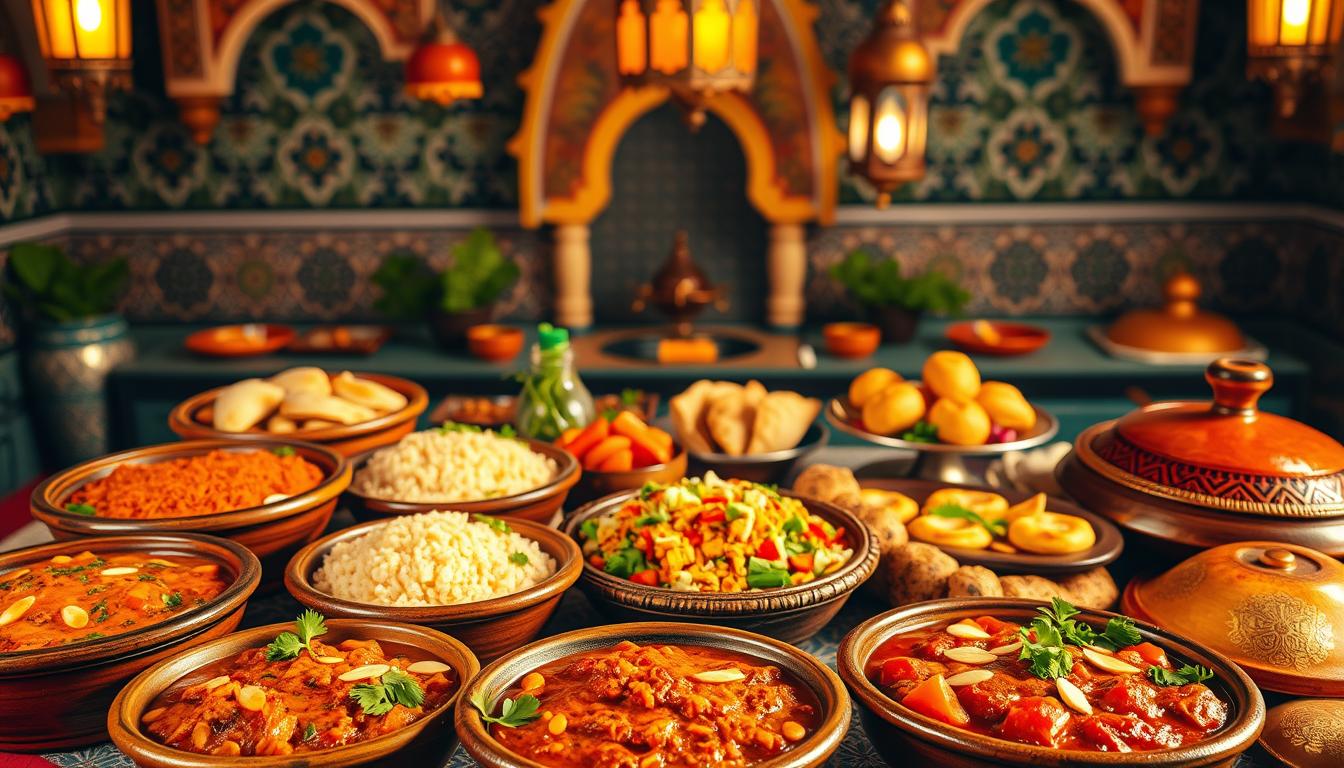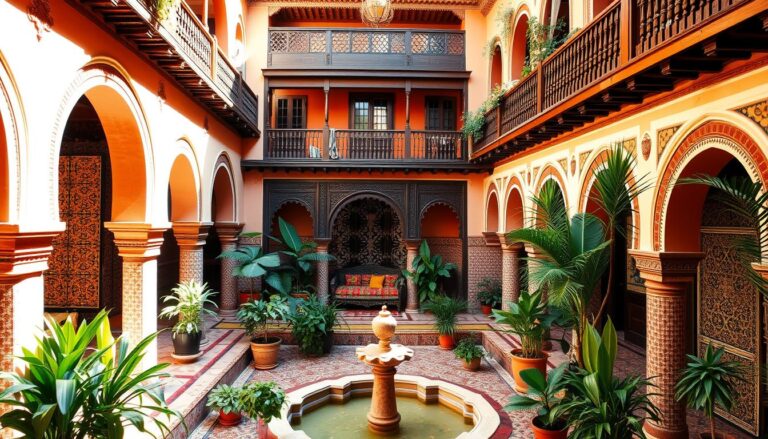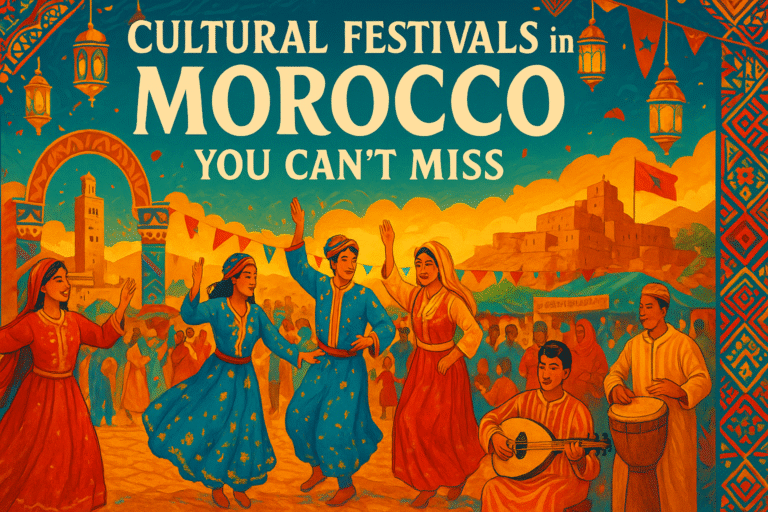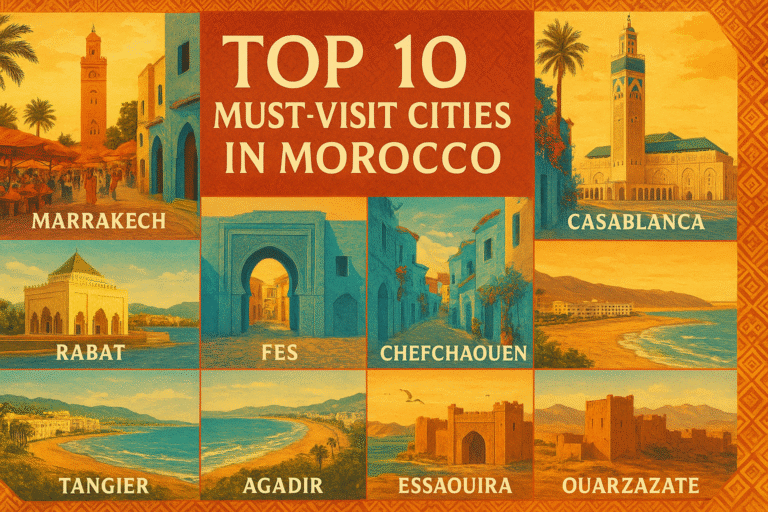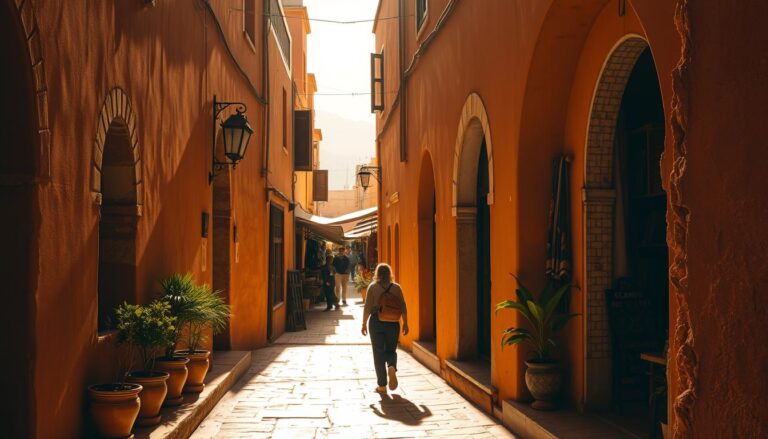Moroccan Food Journey: What to Eat and Where to Find It?
Start a flavorful journey through Morocco’s rich culinary heritage. From Marrakech’s fragrant spices to Essaouira’s coastal tastes.
Find out the traditional dishes that show off Moroccan culture. Learn where to get the real flavors. This trip will show you famous dishes, street food experiences, and top dining spots.
Key Takeaways
- Explore the diversity of Moroccan cuisine
- Discover must-try traditional dishes
- Learn where to find authentic flavors in Morocco
- Experience the country’s iconic street food
- Indulge in fine dining at its best
The Rich Heritage of Moroccan Cuisine
Moroccan cuisine is a mix of Arab, Mediterranean, and African flavors. This blend comes from Morocco’s location at the crossroads of many cultures.
Historical Influences on Moroccan Food
Many cultures have shaped Moroccan cuisine over time. The Arab conquest brought in saffron and cumin, now key in Moroccan dishes. The Mediterranean diet also played a big role, with olive oil, citrus fruits, and tomatoes becoming common.
African influences are seen in the use of spices and chilies. This mix of cultures has made Moroccan food rich and varied.
“Moroccan cuisine is a reflection of the country’s history and cultural diversity.”
This mix of influences has created a unique culinary heritage in Morocco.
Regional Variations Across Morocco
Morocco’s geography, from mountains to coastlines, has led to different cuisines in each region. The Berber communities in the Atlas Mountains use local ingredients like lamb and preserved lemons. Meanwhile, the coast is known for seafood, with dishes like fish and calamari.
These regional differences show the creativity and diversity of Moroccan cuisine.
Essential Spices and Ingredients in Moroccan Cooking
Moroccan cuisine is a mix of flavors from different cultures. It combines Arab, Mediterranean, and African tastes. This mix is seen in its spices and ingredients.
The Moroccan Spice Cabinet
The heart of Moroccan cooking is its spice cabinet. Ras el Hanout is a key spice blend. It means “head of the shop” and is made from the best spices, changing by region and taste.
How to Use Ras el Hanout
Ras el Hanout seasons many dishes, like tagines and couscous. It adds depth and warmth. A little is rubbed on meat or veggies before cooking to boost flavor.
Preserved Lemons and Their Importance
Preserved lemons are key in Moroccan cooking. They add a salty, tangy taste. Made by preserving lemons in salt and their juices, they’re used in tagines and salads.
Key Ingredients That Define Moroccan Flavors
Spices are not the only thing that makes Moroccan cuisine special. Olives, olive oil, and fresh herbs like parsley and cilantro are also important. These ingredients, with spices, create Moroccan dishes’ unique flavors.
| Ingredient | Use in Moroccan Cuisine |
|---|---|
| Ras el Hanout | Used to season tagines, couscous, and other dishes |
| Preserved Lemons | Adds flavor to tagines, salads, and couscous |
| Olives and Olive Oil | Used in cooking and as a finishing touch for many dishes |
Tagine: Morocco’s Iconic Clay Pot Dish
The tagine is more than a meal; it’s a deep dive into Moroccan culture. It’s a slow-cooked stew cooked in an earthenware pot. This dish captures the rich flavors and aromas of traditional Moroccan cooking.
Popular Tagine Varieties
Tagine offers a wide range of flavors, pleasing many tastes and diets. Its versatility makes it a key dish in Moroccan cuisine.
Meat Tagines: Lamb, Beef, and Chicken
Meat tagines are the most famous, with lamb being a top choice for its tender taste. Beef and chicken tagines are also loved, often mixed with spices, dried fruits, and nuts. This creates a hearty and tasty meal.
- Lamb tagine with prunes and almonds
- Chicken tagine with preserved lemons and olives
- Beef tagine with carrots and ginger
Vegetarian and Seafood Tagines
Vegetarian and seafood tagines are great for those who don’t eat meat or want a lighter meal. These dishes feature a mix of vegetables, legumes, and seafood, all cooked in a clay pot.
- Vegetable tagine with zucchini, bell peppers, and eggplant
- Chickpea tagine with spinach and tomatoes
- Seafood tagine with shrimp, mussels, and white fish
How to Eat Tagine Like a Local
Eating tagine is a unique experience with its own customs. Knowing how to enjoy it like a local can make your meal even more special.
Bread as Your Utensil
In Morocco, bread is more than a side dish; it’s a key part of the meal. It’s used to scoop up the stew. Tearing off bread and using it to pick up tagine is the traditional way to enjoy it.
“Bread is the bridge between the plate and the mouth, and in Morocco, it’s the preferred utensil for enjoying tagine.”
Tagine Etiquette and Serving Traditions
When tagine is served, it’s placed in the center of the table. Everyone gathers to share the meal. It’s customary to eat with your right hand, as the left hand is considered impolite in many North African cultures.
By following these traditions, you can fully enjoy tagine like a local.
Couscous: The Heart of Moroccan Family Meals
Moroccan family meals are not complete without couscous. It’s a staple that brings everyone together. Couscous is more than a dish; it’s a symbol of unity and cultural heritage.
Traditional Friday Couscous Ritual
In Morocco, Fridays are for family and couscous. The traditional Friday couscous ritual is a time-honored practice. Families gather to share a meal of couscous, often with vegetables, meat, and sometimes dried fruits and nuts.
This ritual is not just about the food. It’s about bonding and strengthening family ties. The preparation of couscous for Friday meals is a communal effort. Family members help cook, steaming the couscous over a pot of simmering vegetables and meat.
Regional Couscous Variations
Couscous varies across Morocco. Each region has its own unique version. These variations reflect local ingredients, cultural influences, and history.
Seven-Vegetable Couscous
The seven-vegetable couscous is a celebrated dish. It showcases Morocco’s rich agricultural produce. This version is made with seven different vegetables, steamed to perfection with the couscous.
Sweet Couscous Preparations
In some regions, couscous is made with sweet ingredients. This creates a delightful contrast to savory versions. Sweet couscous might include dried fruits, nuts, and spices like cinnamon, making it a dessert or sweet treat.
These variations show couscous’s versatility. It can be adapted to different tastes and occasions. This further cements its place in Moroccan cuisine.
Moroccan Soups and Starters
Moroccan starters take you on a journey through the country’s rich culture. These dishes are not just tasty but also carry deep traditions and history.
Harira: The Comforting Soup of Morocco
Harira is a traditional Moroccan soup. It’s made with tomatoes, lentils, chickpeas, and spices. It’s a comforting dish, often served as a starter or during special occasions.
Ramadan Traditions and Harira
During Ramadan, harira is key for breaking the fast. It’s a nourishing soup that gives energy after fasting.
How to Eat Harira with Traditional Accompaniments
Harira is served with dates and traditional Moroccan bread. The warm soup, sweet dates, and crusty bread make for a classic Moroccan experience.
Popular Moroccan Salads and Appetizers
Moroccan cuisine has many fresh, flavorful salads and appetizers. These dishes mix vegetables, fruits, and nuts.
Zaalouk and Taktouka
Zaalouk is a rich eggplant stew, while Taktouka is a spicy tomato and pepper salad. Both are favorites that show off Moroccan flavors.
Moroccan Bread Varieties
Moroccan bread, like Khobz, is a staple. It’s served with meals or used to scoop up soups and stews. Baked in traditional ovens, it has a unique texture and flavor.
Exploring Moroccan Street Food: Flavors on the Go
Exploring Moroccan street food is a unique culinary adventure. The streets are filled with vendors offering traditional dishes. These dishes are both flavorful and aromatic.

Must-Try Street Food Delicacies
Moroccan street food is a mix of flavors and textures. Two top dishes are Msemen and Beghrir.
Msemen and Beghrir
Msemen is a square pancake with layers of dough. It’s filled with onions, meat, and spices. Beghrir are small, round pancakes with a porous texture. They’re often enjoyed with honey or syrup.
Snail Soup and Grilled Meats
For the bold, Snail Soup is a traditional treat. It’s made with cooked snails in a flavorful broth. Grilled meats, like lamb or chicken skewers, also offer a taste of authentic Moroccan cuisine.
Best Street Food Markets in Major Cities
Morocco’s major cities have bustling street food markets. Here, visitors can try a variety of local delicacies.
Navigating Jemaa el-Fnaa in Marrakech
Jemaa el-Fnaa in Marrakech is famous for its street food. This historic square turns into a food hub at night. It offers traditional tagines and fresh fruit juices.
Hidden Gems in Fez and Casablanca
In Fez, the old medina has street food stalls with local specialties. Casablanca also has hidden gems. Its markets offer a mix of traditional and modern street food.
| City | Popular Street Food | Best Market |
|---|---|---|
| Marrakech | Tagine, Msemen | Jemaa el-Fnaa |
| Fez | Beghrir, Snail Soup | Old Medina |
| Casablanca | Grilled Meats, Fresh Juices | Habous Market |
“The street food in Morocco is incredible. The flavors are so rich and diverse.” – Food Critic
Sweet Treats: Discovering Moroccan Desserts and Pastries
Explore the sweet world of Moroccan pastries and desserts. They are a true culinary delight. Moroccan sweets are not just tasty but also show the country’s rich culture and history.
Traditional Moroccan Sweets for Special Occasions
Moroccan desserts are key in the country’s celebrations. Two favorites are Chebakia and Sellou.
Chebakia and Sellou
Chebakia is a sweet pastry with layers of dough, deep-fried, and honey-soaked. It’s loved during Ramadan. Sellou is a sweet with roasted almonds, sesame seeds, and honey. It shows hospitality and generosity.
Almond Pastries and Honey-Soaked Delights
Almond pastries are a hit in Moroccan cuisine. They’re filled with almond paste and topped with sugar. These pastries, along with honey-soaked treats, are delicious and beautiful. They’re perfect for special times.
The Art of Moroccan Tea and Coffee Culture
Moroccan cuisine is not complete without its tea and coffee culture. Mint tea is key in Moroccan hospitality. Coffee has its own traditions.
Mint Tea Preparation and Etiquette
Making mint tea is an art. It uses green tea, fresh mint, and sugar. It’s served in fancy teapots and small glasses. This shows warmth and welcome. The tea is poured from high to create a frothy top.
Moroccan Coffee Traditions
Moroccan coffee is strong and rich, often spiced with cardamom. It’s served in small cups as a sign of respect. Moroccan coffee culture is lively, with cafes being popular spots.
Where to Find Authentic Moroccan Food
Authentic Moroccan food is easy to find, whether in Morocco or the UK. You can enjoy it on a trip or at home. Knowing where to find it is key.
Dining in Traditional Riads and Restaurants
Traditional riads in Morocco offer a unique dining experience. They have beautiful decor and peaceful gardens. This makes your meal even more special.
What to Look for in an Authentic Restaurant
Choose restaurants that locals love. They serve dishes made with fresh, local ingredients. Look for traditional decor and a lively atmosphere for an authentic meal.
Price Ranges and Expectations
Prices in Morocco vary, from cheap to expensive. A meal in a mid-range restaurant costs 50-100 MAD ($5-$11 USD) per person. In the UK, expect to pay £15-£30 per meal.
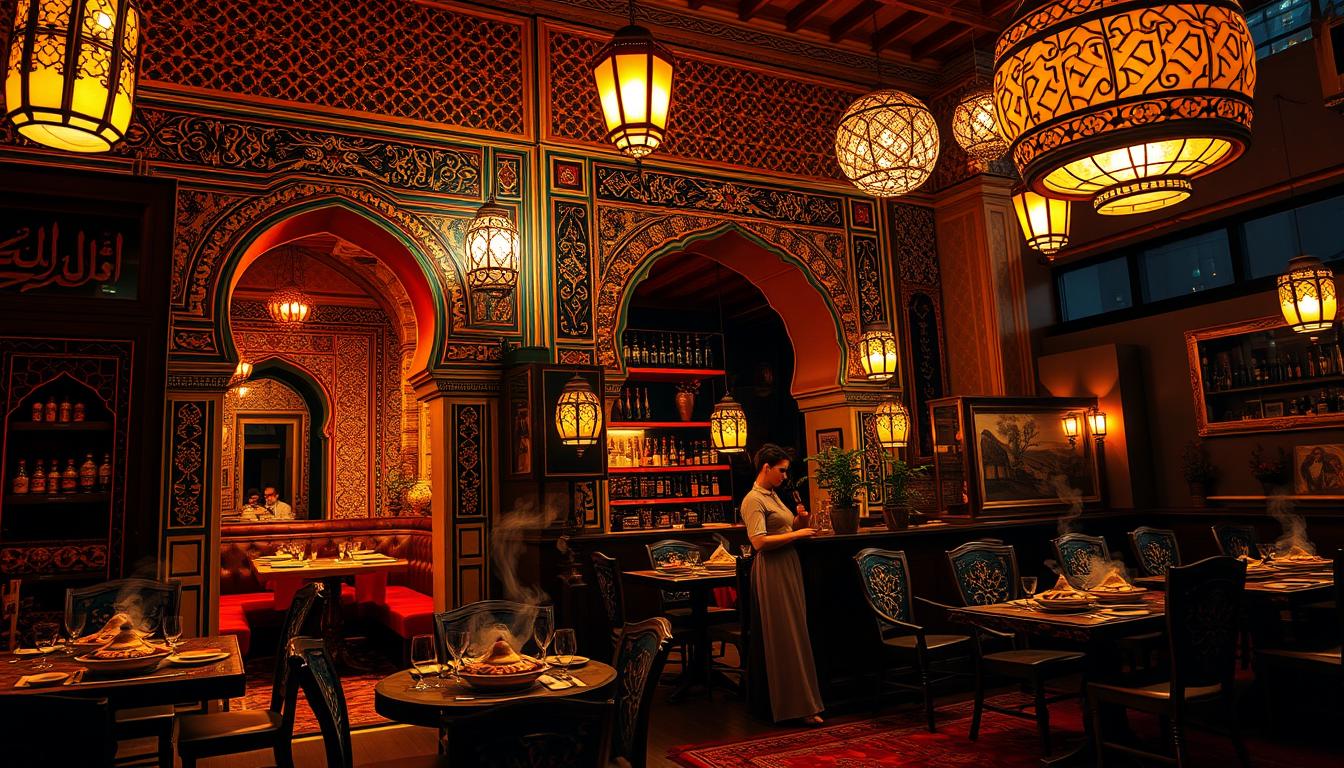
Food Tours and Cooking Classes in Morocco
Food tours and cooking classes in Morocco are great for learning about cuisine. You’ll learn about ingredients, cooking methods, and dish meanings. Many tours also visit local markets and food producers.
| Location | Type | Price Range |
|---|---|---|
| Marrakech | Food Tour | $60-$100 |
| Fez | Cooking Class | $40-$80 |
Finding Authentic Moroccan Cuisine in the UK
In the UK, authentic Moroccan food is easy to find. Just visit one of London’s many Moroccan restaurants. They offer a taste of Morocco right in the city.
Top Moroccan Restaurants in London
Top Moroccan restaurants in London include Mediterraneo and Morito. They are known for their authentic dishes and lively atmospheres.
Moroccan Ingredients in UK Supermarkets
UK supermarkets now carry Moroccan ingredients. You can find spices like ras el hanout, couscous, and preserved lemons. These add a Moroccan flavor to your meals.
Understanding Moroccan Food Etiquette: Eating Like a Local
To really get into Moroccan culture, you need to know about its dining rules. Moroccan meals are more than just food. They’re about the people you’re with, the setting, and the special moments shared.
Traditional Dining Customs
Moroccan dining is filled with tradition. Key parts include hand-washing rituals and eating together.
Hand-Washing Rituals
Washing your hands before eating is a big deal. It shows respect for the meal and the people you’re with.
Communal Eating Practices
Moroccans often eat from a shared dish. They use their right hand to pick up food. This brings everyone closer together.
Tips for Navigating Food Markets and Restaurants
Exploring Moroccan food, whether in markets or restaurants, has its own rules.
Bargaining for Ingredients
In markets, bargaining is the norm. It’s a fun game of give and take, needing patience and a smile.
Tipping Customs and Expectations
Tipping in Morocco is common, especially in eateries. A 10% tip is usually welcome.
| Custom | Description | Tip |
|---|---|---|
| Hand-Washing | Washing hands before meals as a sign of respect. | Be prepared for a hand-washing ritual before dining. |
| Communal Eating | Eating from a shared dish using your right hand. | Practice using your right hand to eat, as using the left is considered impolite. |
| Bargaining | Negotiating prices in markets. | Be prepared to negotiate; it’s part of the culture. |
| Tipping | Showing appreciation for service. | Tip around 10% in restaurants and cafes. |
Conclusion: Embracing the Flavors of Morocco
Moroccan cuisine is a vibrant mix of flavors, shaped by the country’s rich history and cultural diversity. We’ve seen how Moroccan dishes, like tagine and harira soup, offer a wide range of culinary experiences. From traditional riads to street food markets, there’s much to explore.
Embracing Moroccan cuisine is more than just trying new dishes. It’s about diving into the culture and traditions that make it special. Whether you’re planning a trip to Morocco or trying Moroccan flavors at home, the experience will be rewarding.
By embracing Moroccan cuisine, you’ll appreciate the country’s heritage more. You’ll also discover new flavors and cooking techniques. So, start your culinary journey with Morocco’s aromatic spices and bold flavors.
FAQ
What is the significance of tagine in Moroccan cuisine?
Tagine is a slow-cooked stew named after the clay pot it’s cooked in. It’s a key part of Moroccan cuisine. It shows the country’s rich food culture and traditions.
What are the essential spices used in Moroccan cooking?
Ras el Hanout, a mix of spices, is key in Moroccan cooking. Other important spices include cumin, coriander, cinnamon, and ginger. These spices give Moroccan dishes their unique flavors.
How is couscous traditionally prepared and consumed in Morocco?
Couscous is steamed over a flavorful broth. It’s served on special days, like Fridays. It’s eaten with various vegetables, meats, and sauces, and is shared with others.
What is harira, and how is it traditionally consumed?
Harira is a warm soup with tomatoes, lentils, chickpeas, and spices. It’s eaten during Ramadan to break the fast. It’s often served with dates and other treats.
What are some must-try Moroccan street food delicacies?
Msemen, beghrir, and snail soup are popular street foods in Morocco. Grilled meats, like kebabs, are also common.
How can I find authentic Moroccan cuisine in the UK?
You can find authentic Moroccan food in the UK at specialty restaurants, especially in London. Moroccan ingredients are also found in some UK supermarkets. This lets you make traditional Moroccan dishes at home.
What are some traditional Moroccan dining customs?
In Morocco, hand-washing rituals and eating together are important. Meals are eaten with the right hand. Food is also shared among everyone at the table.
How do I navigate food markets in Morocco?
When exploring food markets in Morocco, be ready to bargain for ingredients. Remember to respect local customs. Tipping vendors and being polite can make your experience better.
